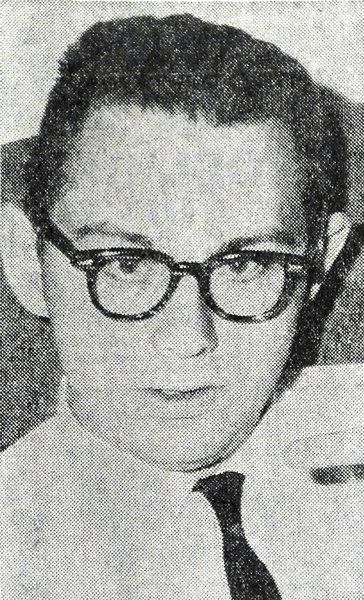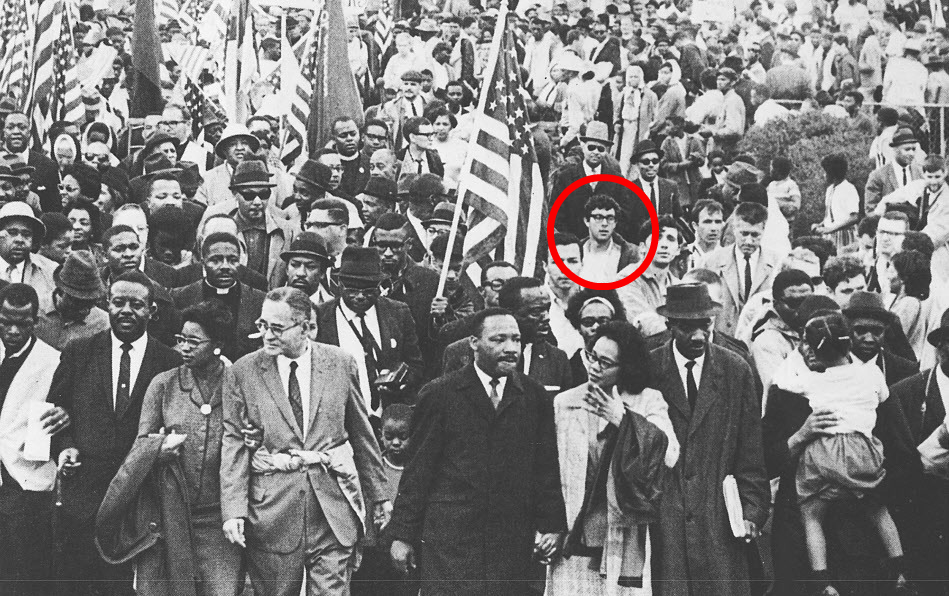On 20 January 2016, the web site Democratic Underground posted a photograph purportedly showing Bernie Sanders participating in a 1965 civil rights march from Selma to Montgomery (Alabama) with Martin Luther King, Jr. The web site identified the man standing "behind Coretta King, just right of Old Glory in the glasses, white 't' shirt, open collar and dark jacket" as the future United States senator and 2016 Democratic presidential candidate:
The man pictured in the above-displayed photograph does bear a resemblance to a young Bernie Sanders, but that similarity isn't sufficient by itself to confirm that Sanders took part in the 1965 Selma to Montgomery march:
The above-displayed image was taken on 26 March 1965, and a caption to the photograph provided by licenser Corbis Images identifies Martin Luther King, Jr. along with several other prominent political leaders but makes no mention of Bernie Sanders:
Dr. Martin Luther King (C) leads thousands of civil rights demonstrators out on the last leg of their Selma to Montgomery 50-mile hike. Others identifiable in the front row include John Davis (2nd from L) of SNCC, King's aide Reverend Ralph Abernathy (3rd from L), Dr. Ralph Bunche (5th from L), Mrs. King (next to her husband) and Reverend Hosea Williams (carrying little girl, R).
This photograph has been widely available for decades, but it wasn't until January 2016 that Bernie Sanders' name became associated with a face in the crowd. Although Sanders has stated that he did participate in the landmark "March on Washington" civil rights event of August 1963 (where Martin Luther King, Jr. delivered his iconic "I Have a Dream" speech), we haven't found any record of Sanders' claiming that he was also present at any other civil rights march involving Martin Luther King, Jr:
On the national holiday named for the civil rights leader, Sen. Bernie Sanders called the Rev. Martin Luther King Jr., "one of the great leaders in American history." Sanders, then a college student, was in the crowd on The Mall in Washington when King delivered his "I have a dream" speech from the steps of the Lincoln Memorial. "We must never forget his heroic efforts to end segregation and racial injustice. It is also important, however, to remember that he fought for a society in which all people had good jobs at good wages and that quality education and health care were available to all. At a time when we have an almost record number of Americans living in poverty, obscene levels of income and wealth inequality and millions working longer hours for lower pay, we still have much to learn from Dr. King's extraordinary life."
As Mother Jones noted, Sander's active participation in the Civil Rights movement was "brief and localized" and effectively ended in 1963:
Sanders' involvement was brief and localized, his sacrifices limited to one arrest for protesting and a bad GPA from neglecting his studies. But Sanders was, in his own right, an active participant in the movement during his three years at the University of Chicago.
Although Sanders did attend the 1963 March on Washington, at which Lewis spoke, most of his work was in and around Hyde Park, where he became involved with the campus chapter of CORE [Congress of Racial Equality] shortly after transferring from Brooklyn College in 1961. During Sanders' first year in Chicago, a group of apartment-hunting white and black students had discovered that off-campus buildings owned by the university were refusing to rent to black students, in violation of the school's policies. CORE organized a 15-day sit-in at the administration building, which Sanders helped lead. The protest ended when George Beadle, the university's president, agreed to form a commission to study the school's housing policies.
That spring, with Sanders as its chairman, the university chapter of CORE merged with the university chapter of SNCC [Student Nonviolent Coordinating Committee]. Sanders announced plans to take the fight to the city of Chicago, and in the fall of 1962 he followed through, organizing picketers at a Howard Johnson in Cicero. Sanders told the Chicago Maroon, the student newspaper, that he wanted to keep the pressure on the restaurant chain after the arrest of 12 CORE demonstrators in North Carolina for trying to eat at a Howard Johnson there.
Sanders left his leadership role at the organization not long afterward; his grades suffered so much from his activism that a dean asked him to take some time off from school. But he continued his activism with CORE and SNCC. In August of 1963, not long after returning to Chicago from the March on Washington, Sanders was charged with resisting arrest after protesting segregation at a school on the city's South Side. He was later fined $25, according to the Chicago Tribune.
Some have pegged the identity of the face circled above as likely being that of Paul Reese, who looked somewhat like a young Bernie Sanders, participated in civil rights events of the time, and was present at the march pictured here:

In short:
- There's no evidence Bernie Sanders took part in the 1965 march pictured above, other than a photograph showing a face in the crowd that bears some resemblance to him. No one verifiably present at that march has recounted seeing Sanders there, no contemporaneous accounts of the march mentioned his name, and the face circled in the above photograph wasn't associated with Sanders' name until some 50 years after the fact.
- Sanders' active involve with the Civil Rights Movement had ended a few years prior to that 1965 march, and there's no record of his having been in Alabama around that time.
- Even Sanders himself hasn't claimed he took part in the march:
One more time: that picture is not of Bernie Sanders, who did not march in Selma. His campaign has *confirmed* this. https://t.co/EseJmycaVX
— Joy Reid (@JoyAnnReid) February 12, 2016


